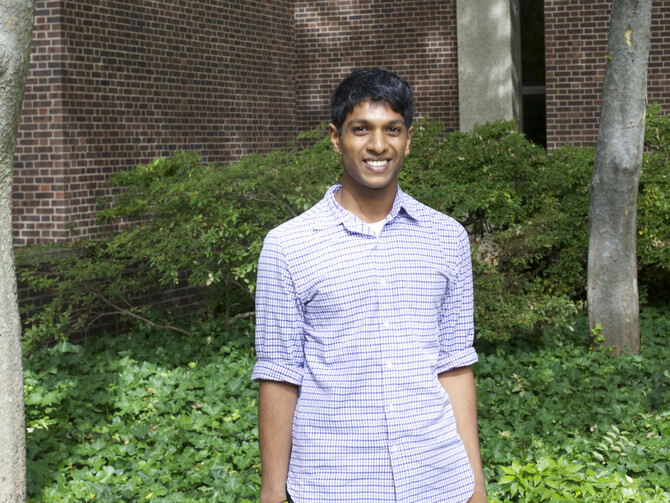Investigating Skeletal Muscle Healing, Penn's Rakesh Goli Finds a Love for Research
Rakesh Goli is leaning toward a career in medicine. But the excitement of scientific research also appeals, leaving him unsure of whether he wants to commit to a future spent exclusively in the clinic.
Fortunately, the University of Pennsylvania sophomore doesn’t have to make up his mind just yet.
This past summer, he got the chance to live the life of a researcher during an internship at the Harvard Stem Cell Institute. The 10 weeks he spent in Boston studying the intricacies of skeletal muscle served to reaffirm his love for research and to possibly complicate his decision when it comes time to choose a career.
In his application essay for the Stem Cell Institute program, Goli expressed interest in cardiac stem cells. As a result, he was matched with the lab of Da-Zhi Wang in the Division of Cardiology at Boston Children’s Hospital and Harvard Medical School. Wang’s group focuses on the development and function of cardiac and skeletal muscle as well as related human disorders.
“It was a very intense experience,” Goli says. “After two to three weeks, I was very independent, checking in with my advisor only once or twice a week.”
Goli’s work built on earlier experiments conducted by lab members, who showed that mice bred to lack two heat shock proteins appeared the same as normal mice when they were just eight weeks old, but had severe defects in healing at the age of one year. When the researchers “sped up” the accumulation of cellular damage by injecting a compound that injures muscle tissue, they saw that mice lacking these heat shock proteins had reductions in their ability to heal tissue damage apparent even as early as eight weeks.
For Goli’s research project, he examined how muscle cell precursors, known as primary myoblasts, were affected in newborn mice lacking the two heat shock proteins under study.
“I was looking to see whether the primary myoblasts proliferate as fast, whether they differentiate as fast and whether they formed muscle fibers at a slower rate,” Goli says.
Though he only had time to run the experiment a few times during his relatively brief stint in the lab, he obtained results indicating that muscle repair defects were present even in 2-day-old mice.
The findings are of interest on a purely scientific, how-the-body-works level, but they also relate to a rare disease called desmin-related myopathy, in which protein accumulates in the body, causing weakness and muscle atrophy.
At the end of the summer, Goli shared his work with a poster presentation and a brief talk, spending hours perfecting the culminating display. He returned to Penn for the fall semester more certain that scientific investigation will be a major part of his future.
“The research aspect of science is something I really want to consider for a future career,” he says.
Goli envisions a variety of possibilities for incorporating science into his career, such as taking time off during medical school to work in a lab or being a consulting physician to a basic science laboratory. He also admits he can’t fully discard the notion of pursuing a doctoral degree in science. Whatever the outcome, he does have someone to advise him in his path. His brother, Rahul, who also attended Penn as an undergraduate, is now a third-year medical student at Penn’s Perelman School of Medicine and is having to make these difficult decisions himself.
For now, Goli is enjoying the exploratory process. He has taken courses in Penn’s Wharton School and is currently gutting his way through rigorous chemistry and biology courses.
He enjoys playing tennis at Penn Park and has recently joined Penn Dhamaka, the University’s first and only all-male dance troupe, which blends South Asian and American styles.
But he hopes to carve out enough free time to soon join a lab and make his mark on research at the University.
“I think the more you learn, the more freedom you’ll have within your career,” he says.








